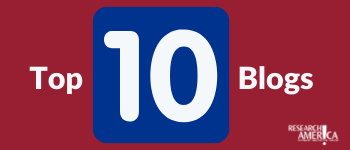The 10 Most Popular Research!America Blog Posts of 2019

As 2019 comes to a close, we’re taking a look back at our 10 most popular blog posts (based on page views) for the year. The posts cover a wide range of topics including basic and clinical research, public health, global health and the successful Raise the Caps campaign. We thank our distinguished group of guest bloggers including young researchers, academics, industry experts, public health professionals, and patient advocates as well as staff here at Research!America who are united in their support for stronger investments in research and innovation to combat diseases and build a safer, healthier nation.
1) Research America Launches Raise the Caps Campaign
March 19: In our most-read post of the year (written by Research!America staff), we announced the launch of the 2019 Raise the Caps campaign. “It’s not smart, or right, for Congress to let caps from the past undercut science for our future. Research!America stands committed to defending the budgets and operating power of America’s world-class, federally-funded research institutions. Together with a wide-ranging collection of allies — patient advocates, scientists, research institutes, pharmaceutical leaders, scientific societies.” Read our top blog post here.
2) Trains, Planes, and A Budget Deal
July 25: Our second most viewed blog post comes from Jenny Luray, Research!America’s Senior Advisor. She wrote about a number of topics including the successful raising of the budget caps for FY20 and FY21, prescription drug costs, PCORI reauthorization, antibiotic resistance among other topics. Read more here.
3) Your Advocacy Made a Difference
August 1: Our third most viewed blog post, also from Jenny Luray, Research!America’s Senior Advisor, discussed the budget caps, need for increased funding for FY20 as well as Research!America’s Civic Engagement Microgrant Program and the launch of a new “Science Meets Science” component encouraging creative cross-disciplinary partnerships between STEM and social scientists.Read more here.
4) Research Funding Hinges on Deal to #RaiseTheCaps
July 11: Emily J. Holubowich, Executive Director of the Coalition for Health Funding and Founding Chair of NDD United, shared her thoughts on FY20 appropriations and the #RaiseTheCaps campaign. “Now is not the time to rest on our laurels or rely on past precedent. Advocates must remain vigilant, and continue to urge lawmakers to #RaiseTheCaps to raise funding for research.” Read more here.
5) Chasing A Cure: The Global Outlook on HIV/AIDS
August 4: This blog post written by Rebecca Mandt, a policy intern at Research!America, recapped a Washington Post Live event where Dr. Anthony Fauci, Director of the National Institute of Allergy and Infectious Diseases described the progress that has been made in HIV treatment, as well as the challenges that must still be addressed to tackle the disease in the United States and globally. Read more here.
6) Science Budgets in Jeopardy
February 28: This blog post (specifically, one of Mary Woolley’s Weekly Letters) covers the budget proposal from early 2019 that featured a 5% cut in non-defense spending as well as the possible cuts to15% or more to some federal science agencies. “If we do not convince Congress to raise the budget caps, science funding will take a major hit. I’m sounding an alarm here.” Please don’t wait to become a partner in our advertising and social media campaign.” Read more here.
7) The Road to Eliminating HPV-Related Cancers
July 26: This blog post, written by Gwendolyn Bogard, communications intern at Research!America, recapped a Hill briefing discussing the severity of cervical cancer and other cancers that are linked to human papillomavirus (HPV). “This should give us pause because HPV is the most common STI – most people will be exposed at some point in their lifetime, and it has been referred to as the “common cold of STIs.” Like the common cold, HPV has different strains that have different effects on humans. At its least harmful, HPV can result in no symptoms, but at its most dangerous, it can lead to deadly cancers.” Read more here.
8) Kudos to Young Scientists
May 30: This blog post, (another issue of Mary Woolley’s Weekly Letter) covered bipartisan draft legislation on a range of healthcare and public health issues, engagement from young scientists, and other topics. “I am so pleased to see the heightened interest of young scientists in upping their engagement with decision-makers and, equally important, with the public.” Read more here.
9) Trust in Science
August 1: This blog post, (a third from the archives of Mary Woolley’s Weekly Letter), discusses of host of topics including trust in science and science communications.”Overall, trust in science is linked strongly to education and income and also tracks with trust in governments and the military. The findings in the report will help us better understand how individuals, both in the U.S. and around the world, view science and scientists, and I expect, shed light on how we can be more effective advocates.” Read more here.
10) Countering Threats to Science and Health
February 14: This post, (a fourth installment from Mary Woolley’s Weekly Letter archives), covers possible budget caps for FY2020, measles outbreaks, vaccines and the medical device tax.”Countering health threats requires a multi-pronged approach: one that incorporates research, education, policy and advocacy.” Read more here.




